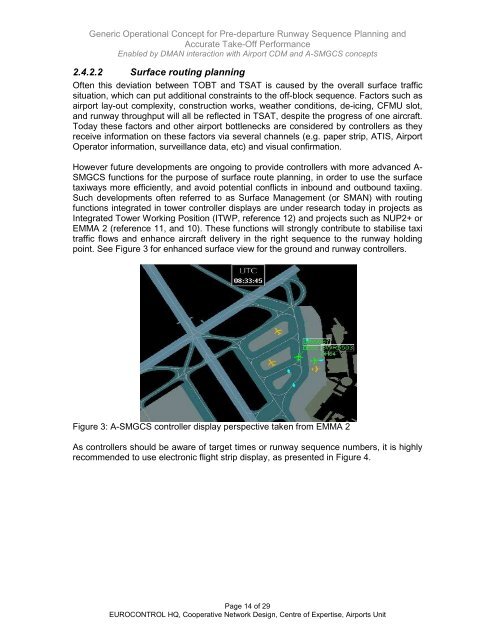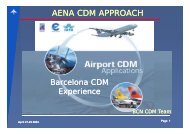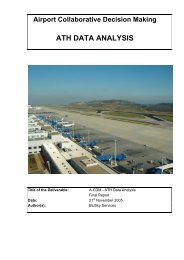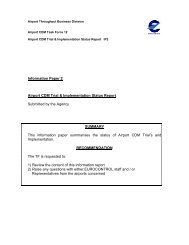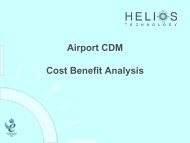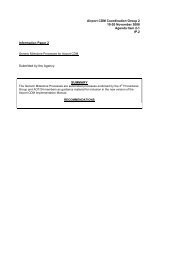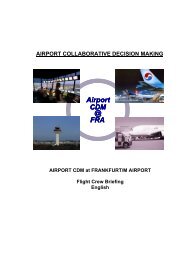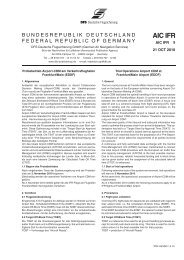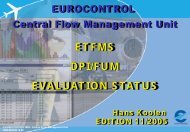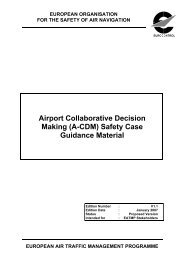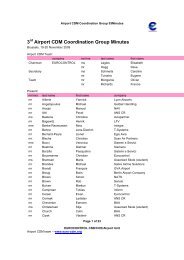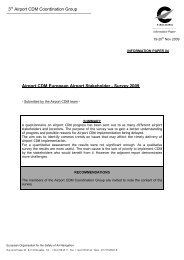Generic Operational Concept for DMAN Interaction v07A - Airport ...
Generic Operational Concept for DMAN Interaction v07A - Airport ...
Generic Operational Concept for DMAN Interaction v07A - Airport ...
Create successful ePaper yourself
Turn your PDF publications into a flip-book with our unique Google optimized e-Paper software.
<strong>Generic</strong> <strong>Operational</strong> <strong>Concept</strong> <strong>for</strong> Pre-departure Runway Sequence Planning and<br />
Accurate Take-Off Per<strong>for</strong>mance<br />
Enabled by <strong>DMAN</strong> interaction with <strong>Airport</strong> CDM and A-SMGCS concepts<br />
2.4.2.2 Surface routing planning<br />
Often this deviation between TOBT and TSAT is caused by the overall surface traffic<br />
situation, which can put additional constraints to the off-block sequence. Factors such as<br />
airport lay-out complexity, construction works, weather conditions, de-icing, CFMU slot,<br />
and runway throughput will all be reflected in TSAT, despite the progress of one aircraft.<br />
Today these factors and other airport bottlenecks are considered by controllers as they<br />
receive in<strong>for</strong>mation on these factors via several channels (e.g. paper strip, ATIS, <strong>Airport</strong><br />
Operator in<strong>for</strong>mation, surveillance data, etc) and visual confirmation.<br />
However future developments are ongoing to provide controllers with more advanced A-<br />
SMGCS functions <strong>for</strong> the purpose of surface route planning, in order to use the surface<br />
taxiways more efficiently, and avoid potential conflicts in inbound and outbound taxiing.<br />
Such developments often referred to as Surface Management (or SMAN) with routing<br />
functions integrated in tower controller displays are under research today in projects as<br />
Integrated Tower Working Position (ITWP, reference 12) and projects such as NUP2+ or<br />
EMMA 2 (reference 11, and 10). These functions will strongly contribute to stabilise taxi<br />
traffic flows and enhance aircraft delivery in the right sequence to the runway holding<br />
point. See Figure 3 <strong>for</strong> enhanced surface view <strong>for</strong> the ground and runway controllers.<br />
Figure 3: A-SMGCS controller display perspective taken from EMMA 2<br />
As controllers should be aware of target times or runway sequence numbers, it is highly<br />
recommended to use electronic flight strip display, as presented in Figure 4.<br />
Page 14 of 29<br />
EUROCONTROL HQ, Cooperative Network Design, Centre of Expertise, <strong>Airport</strong>s Unit


